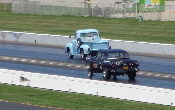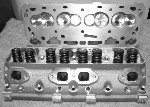|
Author
|
Message
|
|
Ted
|
|
|
Group: Administrators
Last Active: 2 days ago
Posts: 7.5K,
Visits: 205.9K
|
pintoplumber (8/13/2011)
Ted, do you have any idea what kind of horsepower/ torque your mule engine puts out at idle?No. Have reams of data starting at 2300 rpms though as that’s where most of the exhaust testing was started. Much of the cylinder head testing was started at 2500 rpms. Starting the dyno pulls at a lower rpm tends to load the main bearings pretty hard so I refrain from starting the pulls any lower than this in order to extend the life of the engine.
  Lorena, Texas (South of Waco) Lorena, Texas (South of Waco)
|
|
|
|
|
pintoplumber
|
|
|
Group: Forum Members
Last Active: Yesterday
Posts: 1.0K,
Visits: 164.3K
|
Ted, do you have any idea what kind of horsepower/ torque your mule engine puts out at idle?
 Dennis in Lititz PA Dennis in Lititz PA
|
|
|
|
|
Ted
|
|
|
Group: Administrators
Last Active: 2 days ago
Posts: 7.5K,
Visits: 205.9K
|
Nathan. This is not a reground camshaft. It’s just an original old and well used Crower camshaft from their older Monarch series of grinds. Seventies era to be exact. The lifters being used are still the same ones Bob originally purchased with the camshaft for use in his ’56 Merc and I just made it a point to insure that the same lifters went back on the same lobes they were originally run on. Based on the age of the lifters, I’ll go out on a limb and say they were made by Johnson. John. You’re close on the lash as the spec card calls for 0.016” cold. That would end up being ~0.014" hot. The amount of retard that’s present simply reinforces why you degree in a camshaft as opposed to just aligning the marks with twelve pins between them. Just counting the pins doesn’t tell you much other than the engine will probably crank and run and that's assuming the pins are being counted on the oil filter side of the block and not the other side. Here’s a scan of the original cam card for this particular camshaft. Thank Bob Martin for hanging on to this card for all those years. 
  Lorena, Texas (South of Waco) Lorena, Texas (South of Waco)
|
|
|
|
|
John Mummert
|
|
|
Group: Forum Members
Last Active: 3 Weeks Ago
Posts: 916,
Visits: 7.5K
|
Ted, by the specs you show I would guess that the Mule cam was desiged by Bruce Crower when he was working along with Dave Schneider on new cams. If that is the case the lash should probably be fairly tight, around .014". Most of the Crower and Schneider cams I've seen from that time frame were lashed at .012-.014". Since the duration at .006" is 291 and the advertised duration is 280 it has a very short lash ramp. Looks like advertised duration was figured at .010 or .011" lift. Most cam grinders nowadays quote advertised duration at .020" lift and would call this a 265 degree cam. Looks like it was ground 2 degrees retarded if it is installed with a standard timing set. Nathan, any cam can be ground again. It is difficult to add more than .030-.040" additional lobe lift but what really requires removing a lot of material is changing the lobe separation. If you regrind a stock Y-Block cam with 113 degree separation it can't be changed to a 108 separation. The base circle will get very small. If you try to change the lobe separation and add lift you are asking for trouble. Ted has experimented with small base circles and knows the limit, I have never tried less than 1.200". But then I've haven't made a 4" stroke work. New cams with high lift lobes will take the base circle to less than stock just to clean up. Stock is 1.360".
http://ford-y-block.com 20 miles east of San Diego, 20 miles north of Mexico 
|
|
|
|
|
Nathan Soukup
|
|
|
Group: Forum Members
Last Active: 7 Years Ago
Posts: 83,
Visits: 339
|
This may be a dumb question,was the cam re-ground to be used in this engine?,and what brand of lifters were used?Can some of the high performance cams be re-ground for re use?
55 fairlane gasser 312 /c4, 57 f100 292/c4, 52 mainline gasser 302/t10 4speed
|
|
|
|
|
Ted
|
|
|
Group: Administrators
Last Active: 2 days ago
Posts: 7.5K,
Visits: 205.9K
|
John. Thanks for the comments. Always appreciated. Regarding the Crower cam in the 312 dyno mule, it’s over forty years old! It was originally purchased by Bob Martin and powered his 312 powered ’56 Merc with a four speed for thirty some odd years on both the drag strip and the street. At this point that same camshaft is still making noise in the dyno mule. As John points out, this camshaft is on the big side for your everyday driver but starts to shine where head work has been performed. On the flip side, the dyno mule has managed to make 292HP with this cam and with the stock G heads on it. In retrospect, this probably wasn’t the best cam for all the testing that’s been done but the price was sure right as it was sitting in the core engine that was provided in exchange for a new engine build. Here’s some more detail on that particular Crower camshaft. Lobe lift | Intake | Exhaust | 0.006” | 36½° BTDC | 70° BTDC | 0.012” | 26½° | 66° | 0.015” | 24° | 62° | 0.020” | 21° | 60° | 0.025” | 18° | 57° | 0.050” | 7° | 46° | Full lobe lift | 0.299” | 0.299’” | 0.050” | 50½° ABDC | 12° ATDC | 0.025” | 61° | 23° | 0.020” | 64° | 25° | 0.015” | 66½° | 28° | 0.012” | 69° | 30½° | 0.006” | 75° | 37½° | | | Advertised Dur | 280° | 280° | Dur @ 0.015” | 270½° | 270° | Dur @ 0.020” | 265° | 265° | Dur @ 0.050” | 237½° | 238° | Lobe centerline | 112° | 107½° | Lobe centers | 109.75° | Lift w/1.5 rckrs | 0.449” | 0.449” | Lift w/1.6 rckrs | 0.478” | 0.478” |
  Lorena, Texas (South of Waco) Lorena, Texas (South of Waco)
|
|
|
|
|
John Mummert
|
|
|
Group: Forum Members
Last Active: 3 Weeks Ago
Posts: 916,
Visits: 7.5K
|
I believe the EMC headers are well below their tuned range at 2500rpm leading to the dip at the start of the test. The ports in the EMC heads are opened up considerably with larger than stock gasket openings on the intake side and 1.98" valves. The production heads have stock gasket openings and 1.94" valves. I'd also point out that we don't know much about the Crower cam in the Mule. It may have considerable seat timing that might not make it friendly at low RPM and it is close to 240 degrees @.050" putting it toward the upper end of street friendly cams. I can tell you I sell probably 30-40 224@.050" cams for every 240@.050" cam for Y-Block street use. I'm glad to see the 1-1/2" Sandersons do well. Flow bench testing showed that the exhaust exited the port in a much more confined column than the stock iron heads leading me to believe they would work better with small headers than the stock heads. The iron heads need very large headers to work well, due in large part to the way the exhaust leaves the head. Thanks Ted for going to this extra effort. This is great information for us and the end users also.
http://ford-y-block.com 20 miles east of San Diego, 20 miles north of Mexico 
|
|
|
|
|
Don Woodruff
|
|
|
Group: Forum Members
Last Active: 12 Years Ago
Posts: 190,
Visits: 1.6K
|
It is really impressive that an almost 40 horsepower increase was added and that the engine was able to make 370 horsepower through 1 1/2 inch headers.
|
|
|
|
|
charliemccraney
|
|
|
Group: Moderators
Last Active: 5 days ago
Posts: 6.1K,
Visits: 443.0K
|
That is very likely. Actually, I think I spoke too quickly, with the Sanderson headers, it might be alright. It is only with the EMC headers that it appears to have a significant dip below 2500rpm. I won't be in the market for a set for at least another year so I'll have plenty of time to find out how their street manners are but when I do get some, it will not be for a NA motor so they will be getting some additional "help" to enhance the low end.
Lawrenceville, GA
|
|
|
|
|
speedpro56
|
|
|
Group: Forum Members
Last Active: Last Year
Posts: 1.3K,
Visits: 9.2K
|
Charlie, probably an unported set would work great with your setup where the torque figures would be stronger on the lowend and cheaper to purchase as well. With a mild build that's what I'll do anyway and they'll still beat a good ported set of iron heads.
-Gary Burnette-
|
|
|
|